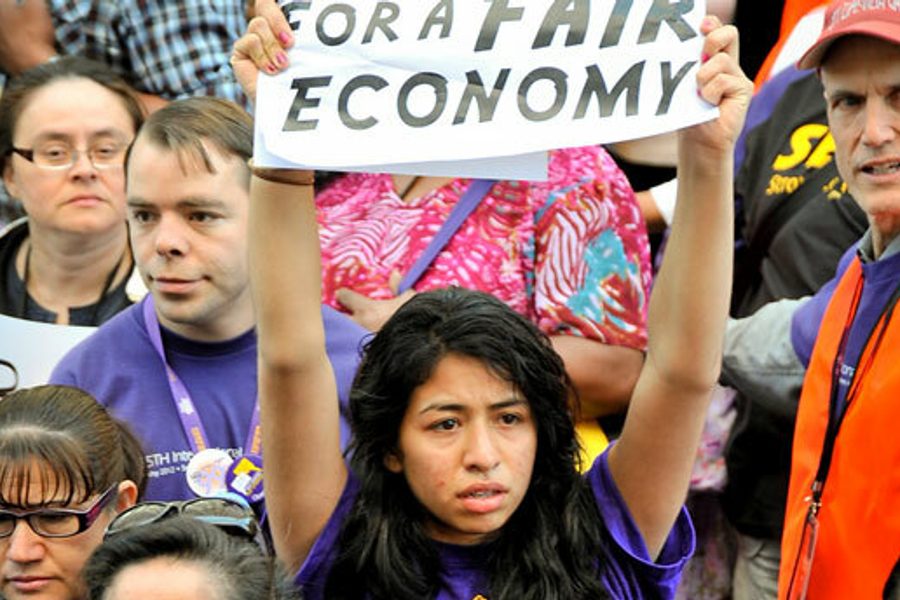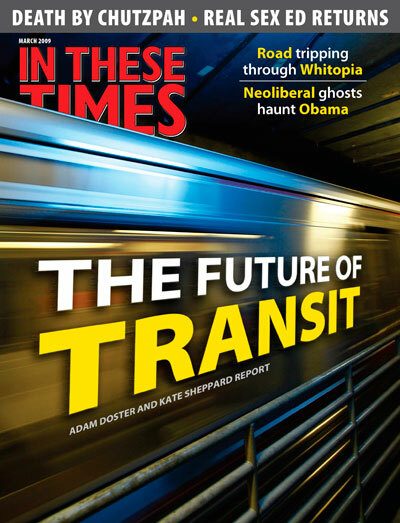A Spectre is Haunting America
Ghosts of neoliberalism trouble Obama’s response to the recession
David Moberg

Since 1980, the idea that government is bad has dominated American politics – from Ronald Reagan’s maxim that government is the problem, not the solution, to Bill Clinton’s declaration that “the era of big government is over.” But President Barack Obama’s inaugural address marked the beginning of a new – or at least renewed – paradigm that shifts the balance between government and markets, or public and private power.
“The question we ask today is not whether our government is too big or too small, but whether it works – whether it helps families find jobs at a decent wage, care they can afford, a retirement that is dignified,” Obama said in his inaugural speech. “Nor is the question before us whether the market is a force for good or ill. Its power to generate wealth and expand freedom is unmatched, but this crisis has reminded us that without a watchful eye, the market can spin out of control and that a nation cannot prosper long when it favors only the prosperous.”
Obama’s pragmatic formula rejects the prevailing ideology that the smaller government, the better (except for the military and the protection of property rights). It also taps into the notion that while Americans may not like big government in theory, they want government to solve many problems. And the problems now facing Americans demand a much broader role for government.
Working for whom?
The issue is not just what works, but also for whom and for what ends. Obama needs to shift policymakers and the public toward seeing that government, when well run, can be a beneficial force that does more than monitor the flaws and clean up the wreckage left by the market and by big corporations.
The majority of working- or middle-class Americans will trust government more only if it consistently works for them. And if government works for them, then the economy will work better. That’s the message of economist Jeff Madrick’s new book, The Case for Big Government (Princeton University Press, 2009).
Despite the laissez-faire culture in the United States, government intervention – from protecting infant industries to forming public universities – has always played a central role in the country’s development. And big government has produced results, Madrick argues, such as faster growth and greater equality during the first quarter-century after World War II, particularly when compared to the stagnant standard of living for most Americans and the growing inequality and insecurity that resulted from neoliberal policies of recent decades.
Government, Madrick argues, has advantages over private corporations. It has an ability to coordinate large systems, to take a long-term perspective, to attend to the common good, to be held accountable, to provide greater stability and to benefit everyone (positive externalities, in economist’s terms). While the limits of government are endlessly trumpeted, few note the numerous areas where big government often works best.
Baby steps
In his first weeks in office, Obama’s recognition of government’s potential has been mixed, with far more promise in his economic stimulus plan than in his approach to fixing the financial sector.
Economists of diverse political views agree that the roughly $900 billion stimulus package over two years will likely reduce unemployment, but is not big enough to lift the economy out of a deepening slump. Although one-third of the plan goes toward tax cuts and rebates that are not the most effective way to create jobs, they at least are skewed to low- and moderate-income households, making them more potent than the tax cuts tilted to richer households and business that Republicans favored.
The tax cuts will take effect quickly, which is important. But equally quick, and more effective in stimulating demand, are the expansions of unemployment insurance, Supplemental Social Security benefits, food stamps, health insurance and education grants, which Republicans dismiss as social welfare. Likewise, aid to states to avoid layoffs and service cuts deliver quick results. The Congressional Budget Office calculates that 85 percent of the House stimulus bill and 94 percent of the Senate bill would take effect by the end of September 2011.
But the economy will need even more public investment before then. If the recession deepens, as seems likely, a recovery will have barely begun by the end of 2010. And employment growth could be unusually slow, as it was in the jobless recoveries from the much shallower downturns of 1990-91 and 2001.
Moreover, the past two recoveries have relied on asset bubbles: the dot-com boom and the housing boom. This time, recovery must be based on the real economy, which produces goods and services that provide employment and broad-based prosperity. It must also reverse the current accounts deficit that has left the global economy so unbalanced.
That will require greater public investment and – to the horror of the right wing – greater government planning of the new economy for sustainable, long-term growth. In a tentative fashion, Obama’s stimulus plan does this.
First, it encourages growth of alternative energy production and energy efficiency, including creation of an electricity grid that can better take advantage of wind power and other alternatives.
Second, the stimulus package includes investment in roads, transit, ports, water systems and other physical infrastructure. This creates immediate employment and increases both productivity and investment in the private sector.
Third, the plan invests in developing the human skills needed for a new economy – from pre-school to universities, covering both modernization of buildings, as well as aid to students, research and strained school systems.
The right hates even these modest steps toward planning. For example, free traders have attacked the stimulus’ modest Buy America provisions. But such requirements have been standard in past infrastructure legislation. Most of the provisions do not violate trade agreements, says Lori Wallach, director of Public Citizen’s Global Trade Watch. She notes that other governments also insist that public funds kick-start their domestic economies (such as France requiring its auto industry to invest domestically as a condition of industry aid).
The provision will stimulate more domestic job creation, especially in manufacturing, ultimately helping to restore the United States as a market for imports. And it will nurture manufacturing in key emerging sectors needed for long-term growth, like alternative energy systems, where domestic production has suffered from neglect by private investors and public policy.
The package invests too little in traditional infrastructure and in many cases fails to make the strategic choices that it should to maximize future benefits, such as favoring infrastructure that discourages sprawl, renovates central cities and promotes varied forms of public transportation. (See “The Future of Transit,” page 17.) It does not launch many needed new projects, like development of high-speed rail systems. Yet it is a dramatic departure from Republican anti-government deference to exclusively private decision-making by corporations.
Nationalization needed
The dead weight of anti-government ideology is taking its heaviest toll on Obama’s emerging plans for reviving and reforming the financial system, even though the Bush administration had already promoted a big – if often bad – government role.
After dallying far too long out of deference to private speculators and hostility to government intervention, former Treasury Secretary Henry Paulson and Federal Reserve Chairman Ben Bernanke committed trillions of dollars in various efforts, from capital infusion to financial guarantees, to resolve the financial crises caused by subprime loans and the huge market of worthless, derivative financial investments.
But despite the great cost of these efforts, the anticipated losses for banks continue to grow, banks are reluctant to lend, and toxic assets still on the books are crippling the financial system. Yet bank executives who put the world economy in the toilet continue to enrich themselves at the public’s expense. They gave themselves an estimated $18.4 billion in bonuses last year, and in the case of former Merrill Lynch CEO John Thain, bought a $35,000 toilet.
University of California at Berkeley economist Brad DeLong argues that the government has three options with the banks: It could let the insolvent banks fail, as it did in the early years of the Depression. (Of course, when Paulson and Bernanke allowed only one investment bank, Lehman Brothers, to collapse, the crisis deepened.) It could try to bail out the banks in some way, which was the path of Bush and now Obama. Finally, it could nationalize the banks.
Nationalization is the best option. And it will work much better if it’s done forthrightly, not through a creeping nationalization that many observers think will be the ultimate outcome of the bumbling bailout.
Economists like DeLong, Nobel laureates Joseph Stiglitz and Paul Krugman, and William Buiter, former chief economist of the European Bank for Reconstruction and Development, are among the growing advocates of nationalization or full public ownership and control. Many observers, however, dismiss it out of hand.
The financial-political elite, such as Treasury Secretary Timothy Geithner, National Economic Council Director Larry Summers, and Clinton’s former Treasury Secretary – and disgraced former Citigroup director – Robert Rubin, find nationalization undesirable as well as unworkable. “We have a financial system that is run by private shareholders, managed by private institutions, and we’d like to do our best to preserve that system,” Geithner told reporters on Jan. 28
“America is not about widespread nationalization,” New York Times columnist Andrew Ross Sorkin recently wrote. Manhattan College financial historian Charles Geisst says that nationalization is “not a term in the American vocabulary.” And Max Holmes, an asset management executive, warned in a Times op-ed, “Nationalization would be hugely expensive and would undermine our free market system.”
But it is the private managers who have been “hugely expensive” to the government and to the millions of Americans who are losing jobs and income. These managers have also undermined “our free market system.” If the test is what works, why not seriously consider nationalization?
After all, Sweden’s center-right government undertook nationalization, which worked well during its financial crisis in 1992. The cost of nationalizing the nation’s biggest, effectively insolvent banks would be high, but continuing the “lemon socialism” of the bailout may prolong the crisis and prove more expensive, thus dragging down the economy.
Unlike the emerging plan to create a government “bad bank” to buy up toxic bank assets, nationalization allows the government to take control of, and benefit from, the increased values of both good and bad assets over time. There would be little or no problem setting a price for those toxic assets, and it would be easier for the nationalized banks to resolve the roughly $55 trillion in credit default swaps hanging over the financial system.
Nationalization would also mean that the shareholders and executives who profited from the banks’ wild speculation would pay a price for their reckless greed. A continued bailout with a bad bank is costly public protection for private shareholders, even if the government receives stock as part of the bailout deal. And with nationalization, the government would have enough control to make sure banks resumed lending and stopped feathering executives’ nests.
There’s a strong case that nationalization would work best, thereby meeting Obama’s criteria for pragmatic governance. But private interests and ideological blinders are blocking the administration from seriously considering it. Ironically, nationalization could do more to save – and perhaps even favorably transform – capitalism than more timid uses of government power and money.
The era of big government, it has turned out, isn’t over after all. But the much-needed era of big thinking remains in its precarious infancy.
David Moberg, a former senior editor of In These Times, was on staff with the magazine from when it began publishing in 1976 until his passing in July 2022. Before joining In These Times, he completed his work for a Ph.D. in anthropology at the University of Chicago and worked for Newsweek. He received fellowships from the John D. and Catherine T. MacArthur Foundation and the Nation Institute for research on the new global economy.









